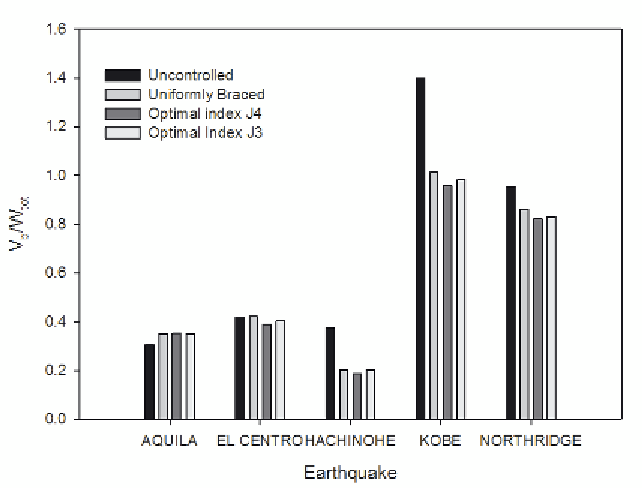Geology Reference
In-Depth Information
Figure 13. Base shear comparison
When increasing the DOFs of the building the
Sequential Search (SS) using El Centro Earthquake
does not converge to a reasonable solution even
when the more stable performance index (
J4
) is
used. Stable and practical configuration can be ob-
tained instead using either WOBI or ESPS search
algorithms (Figure 18). When considering also
the damper distributions obtained with the other
four earthquake records that are shown in Figure
19, it can be assumed that they all converge to
similar distribution when WOBI and ESPS search
algorithms are adopted except for the case of Kobe
earthquake where more dampers are needed at the
upper floors. This can be explained by the higher
mode effects, that in tall buildings is more evident
and by the frequency content of the earthquake.
The damper distributions obtained with the perfor-
mance index
J3
bring to more stable distributions
when the WOBI and ESPS search algorithms are
used, while the SS does not converge to an optimal
solution (Figure 20). Repeating the procedure for
all the four earthquake records bring to the same
conclusion that the damper distributions obtained
with
J3
index are unstable when SS algorithm is
adopted, while it converges to similar distributions
with WOBI and ESPS.
All distributions are however affected by the
type of ground motion selected and therefore are
affected by the frequency content of the earthquake
ground motion (Figure 21).
CONCLUSION
Passive energy dissipation systems (e.g. viscous
dampers, metallic dampers, friction dampers etc)
have been used extensively for the protection of
civil engineering structures against strong earth-
quakes, therefore in this chapter are shown and
compared three practical search methods for the
optimal placement and design of dampers. They
are called:
•
Sequential Search (SS)
•
Worst-Out-Best-In (WOBI)

Search WWH ::

Custom Search